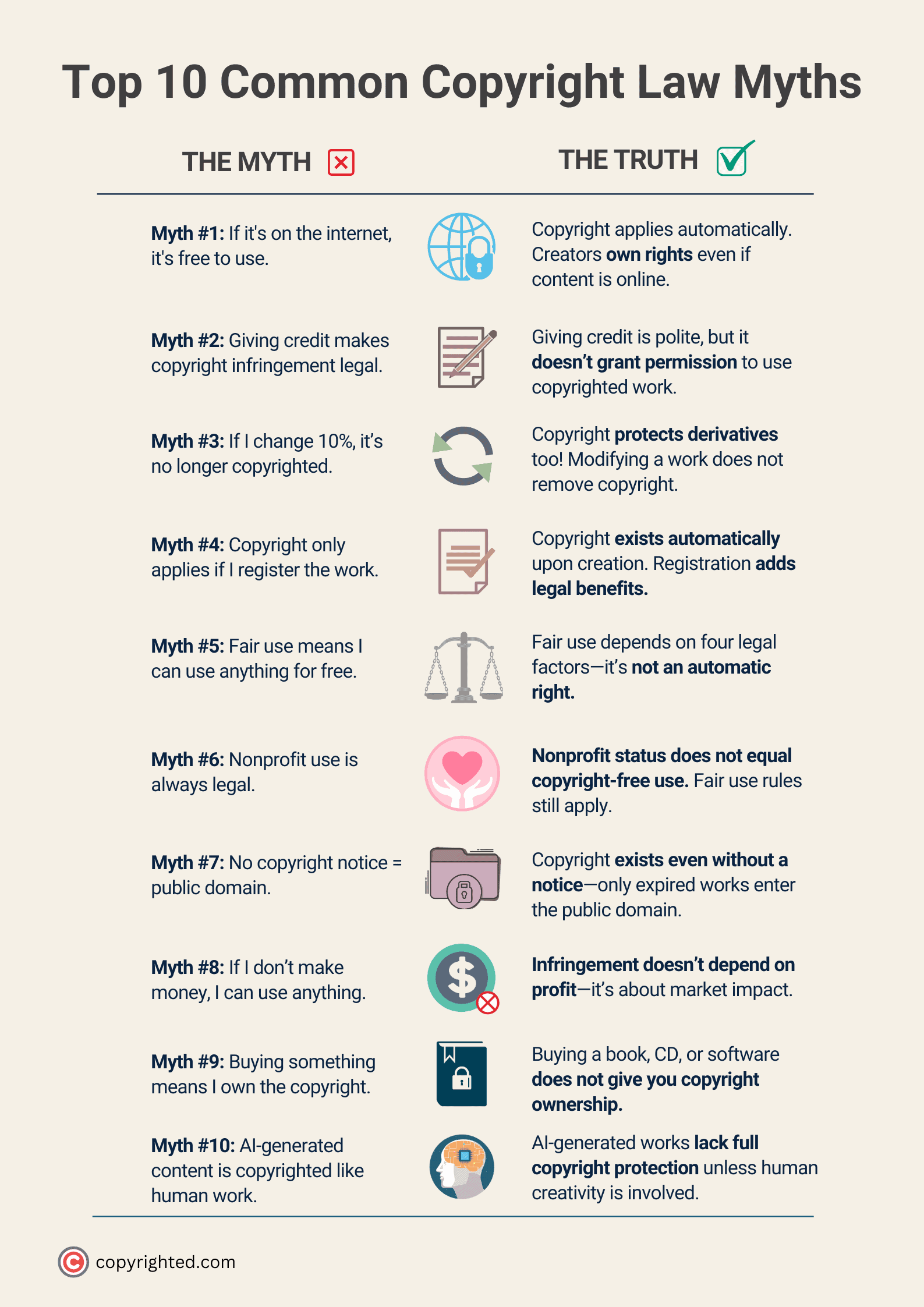Copyright law is often misunderstood, leading to costly mistakes. Many mistakenly believe that “everything online is free to use” or that “altering 10% of a work makes it original,” leading to legal issues, financial losses, or unintentional infringement.
Misinformation spreads quickly, making it difficult to distinguish facts from myths. As a result, content creators, businesses, and internet users may unknowingly violate copyright laws, risking lawsuits, takedown notices, or the loss of intellectual property rights.
This article debunks common copyright myths with clear explanations. By the end, you’ll understand the common copyright myths, why they exist, and how these myths can lead to legal issues.
- Copyright protection applies automatically upon creation, and registration is not required but strengthens legal claims.
- Fair use is a case-by-case legal defense, not an automatic right, and depends on multiple factors, including market impact.
- Believing myths about copyright can lead to serious legal consequences, including lawsuits, financial penalties, and content takedowns.
Table of Contents
Top 10 Common Copyright Law Myths and the Truth
Misinformation about copyright law leads many people to make costly mistakes. Some assume that anything found online is free to use, while others believe that simple modifications or giving credit remove legal restrictions.
These common misconceptions can result in legal issues and intellectual property disputes. Let’s look at the top 10 copyright myths and the facts behind them.

Myth #1: “If it’s on the internet, it’s free to use.”
False—just because something is online isn’t free to use. Under 17 U.S.C. § 102, copyright applies automatically upon creation, regardless of where the work is published.
Even if content is publicly accessible, the creator still holds exclusive rights unless they explicitly grant permission through a license like Creative Commons.
Myth #2: “Giving credit makes copyright infringement legal.”
False—while giving credit is ethical, it does not override copyright law. Under 17 U.S.C. § 106, the copyright holder has exclusive rights to reproduce, distribute, and display their work, and proper attribution does not grant automatic legal permission.
You must obtain a license or rely on fair use, which is determined on a case-by-case basis under 17 U.S.C. § 107.
Myth #3: “If I change 10% of a work, it’s no longer copyrighted.”
False—modifying a work does not remove its copyright protection. The concept of a “10% rule” is a common myth, but copyright law does not set a percentage for allowable modifications.
A derivative work based on an existing copyrighted work still requires permission from the original creator.
Myth #4: “Copyright protection only applies if you register the work.”
False—copyright protection is automatic upon creation. However, registration with the U.S. Copyright Office under 17 U.S.C. § 411 provides legal benefits, such as the ability to sue for statutory damages in an infringement case.
While registration is not required for protection, it strengthens legal claims.
Myth #5: “Fair use means I can use anything for free.”
False—fair use is a legal defense, not an automatic right. It is determined case by case based on four factors: purpose of use, nature of the copyrighted work, amount used, and effect on the market.
Just because a work is used for education or commentary does not guarantee fair use protection.
Myth #6: “Nonprofit use is always legal under copyright law.”
False. While nonprofit status can be a factor in fair use analysis, it does not automatically make copyrighted material free.
Section 107 of the US Copyright Act considers whether the use is transformative and whether it affects the original work’s market value. Nonprofit organizations must still obtain permission for copyrighted works unless fair use applies.
Myth #7: “Anything without a copyright notice is public domain.”
False—under 17 U.S.C. § 401, copyright notices are optional for works created after March 1, 1989, due to the U.S. joining the Berne Convention. Works are protected upon creation, even without a copyright notice.
Public domain status only applies if the copyright has expired or the creator has explicitly dedicated the work to the public.
Myth #8: “I can use any copyrighted content as long as I don’t make money from it.”
False—copyright infringement is not based solely on profit, as using copyrighted content without permission can still be illegal even if no money is made. Courts consider whether unauthorized use affects the original work’s market, not just whether the user profits.
Myth #9: “If I buy something, I own the copyright.”
False. Buying a physical or digital copy of a work, like a book, CD, or software, does not transfer copyright ownership.
Based on 17 U.S.C. § 202, ownership of a copy is separate from ownership of copyright. Only a written agreement explicitly transferring copyright, as required under 17 U.S.C. § 204, grants ownership rights beyond personal use.
Myth #10: “AI-generated content has the same copyright protection as human-created work.”
False. U.S. copyright law does not grant complete copyright protection to AI-generated content without human authorship.
The U.S. Copyright Office’s 2023 guidance states that only those who work with human creative input are eligible for copyright. AI-generated works without substantial human involvement are not protected.
Why Do Copyright Myths Exist?
Copyright myths exist due to misinformation, misinterpretation of legal terms, and outdated legal beliefs. These factors create confusion, causing many to accept and spread false information unknowingly.
Misinformation Spreads Online and Through Social Media
False copyright advice circulates quickly online, especially on social media, blogs, and forums. Many users share unverified claims, leading others to believe misleading or incorrect information.
Misinterpreting Legal Terms and Copyright Rules
Many people misunderstand legal terms like “fair use” and “public domain,” like mistakenly assuming all non-commercial use qualifies as fair use. However, there’s a four-factor test to determine if a use is legally permitted, and misinterpreting these rules spreads false information.
Outdated Assumptions About Copyright Law
Copyright laws have evolved, but many people still rely on outdated information. For example, some believe copyright lasts only 50 years, but under 17 U.S.C. § 302, works created after January 1, 1978, are protected for the author’s lifetime plus 70 years.
How Copyright Myths Can Lead to Legal Issues
Believing copyright myths can result in serious legal and financial consequences. Many individuals and businesses unknowingly violate copyright law, assuming they are protected by misinformation.
Here’s how these misunderstandings can lead to legal trouble:
1. Copyright Infringement Lawsuits
Acting on false copyright beliefs can lead to lawsuits, where copyright holders sue for damages. According to 17 U.S.C. § 501, copyright owners can legally act against infringers.
2. Financial Penalties and Statutory Damages
Under 17 U.S.C. § 504, copyright holders can seek financial compensation. Courts may award actual damages or statutory damages ranging from $750 to $30,000 per work and up to $150,000 per work if the infringement is willful.
3. Business Liability and Brand Reputation Damage
Businesses that use copyrighted materials without permission risk lawsuits, negative publicity, and reputational damage. Companies often assume that using online images, videos, or music is fair game, leading to infringement claims.
4. Website Takedowns and DMCA Notices
Copyright owners can issue Digital Millennium Copyright Act (DMCA) takedown notices under 17 U.S.C. § 512, forcing websites, social media platforms, and search engines to remove infringing content.
Failing to respond to these complaints can lead to content deletion or account suspension.
For instance, YouTube regularly removes videos that contain copyrighted music or footage without permission. Many content creators mistakenly believe that using small clips or giving credit makes it legal, only to find their videos taken down and their accounts penalized.
5. Criminal Charges for Willful Infringement
While most copyright violations are civil cases, intentional infringement for financial gain can lead to criminal charges under 17 U.S.C. § 506. Criminal penalties may include fines of up to $250,000 and up to five years in prison.
6. Losing Rights to Your Own Work
Misunderstanding copyright laws can also lead to creators unintentionally giving away their rights. Some believe copyright only applies if they register their work, leading them to neglect proper documentation, yet copyright transfers must be in writing.
For example, if a musician signs a vague contract without realizing they are giving up their songs’ rights, they may lose legal ownership. So, if a significant label later uses their music, they would have no claim to royalties or control over their work.
Frequently Asked Questions
Does giving credit to the creator make copyrighted content free to use?
No, giving credit does not override copyright law; permission or fair use still applies.
Can you use any image or video as long as it’s labeled ‘royalty-free’?
No, “royalty-free” means you don’t have to pay ongoing fees, but you still need a valid license.
Is all public domain content free to use?
Yes, but ensure the work is truly in the public domain and not mistakenly assumed to be.
Can you legally modify copyrighted content and claim it as my own?
No, modifying a work does not remove its copyright; derivative works still require permission.
How can you make sure I’m not violating copyright laws?
Always verify copyright status, obtain proper licenses, and understand fair use guidelines.


